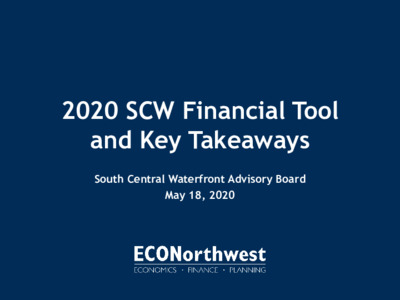Item 2.a.: Consultant Presentation on SCW Financial Framework — original pdf
Backup

2020 SCW Financial Tool and Key Takeaways South Central Waterfront Advisory Board May 18, 2020 Financial model implications Financial model overview Affordable housing discussion Observations from modeling Agenda 2 SCW District Feasibility 3 Methods Update of 2016 modeling for Framework Plan to provide Council with directional indicators when considering policy options Parcel-based pencil-outs that consider plan entitlements, infrastructure costs, affordable housing, and bonus participation fees A snapshot look at the district build out, as though all development delivered simultaneously 4 Methods 2020 financial model accounts for: 2016 SCW Framework Plan entitlements Late 2019 market conditions (costs and revenues) 305 S Congress (Statesman) PUD proposal More precise infrastructure costs, including proposed Statesman site plan Bonus participation fees Affordable housing (including multiple OTC options and Statesman targets) 5 Financial Evaluation - Key Takeaways Developments of the scale contemplated in the 2016 SCW Plan may be financially infeasible, even before accounting for infrastructure and affordability requirements New development that matches the City’s vision will require public subsidy Infrastructure investments will require coordination between public and private sectors Achieving the 20% housing affordability target is infeasible without public subsidy 6 Affordable Housing – Key Takeaways 2016 Framework Plan: Achieving goal requires substantial project-by-project subsidies Updated 2020 Financial Tool: Reaffirmed 2016 results. Most feasible development types are low- and mid-rise 100% affordable rental projects: In the OTC parking lot In adjacent neighborhoods, without requiring onsite units for condo buildings 7 Financial Model Tour 8 Model Multiple inputs allow for the creation of “policy scenarios” 9 Model Three buildout scenarios are modeled based on: (1) 2016 Plan; (2) Statesman PUD proposal & Crocket w/ site modifications, and (3) A hybrid Statesman PUD proposal limited to 2016 plan heights & modified Crocket site 10 Model Outputs show development feasibility, district feasibility gap, and affordable housing shortfall (if any) for the District for each set of “input scenarios” 11 Nine different scenarios are modeled for One Texas Center to consider options: • Rental / ownership • Low-Mid-High rise • 100% affordable / mixed-income Model 12 Includes summary of parcel-by-parcel performance, which can be compared to 2016 analysis Model 13 Affordable Housing 14 2016 Framework Plan Affordability 20% of housing should be income restricted 100% affordable building on the OTC parking lot Affordable housing target less than 5% of all units on the Statesman site – offsetting major infrastructure and open space commitment Targeting households making 60% MFI for rental units Affordable requirements varied by site 15 Draw Lessons from Prior Experience Snoopy PUD considered income-restricted housing outside of SCW district boundaries* Downtown bonus district requires 10% affordable housing within the bonus Most regulating plans have a single affordability requirement that has never been revised based on market conditions Condos are difficult to deliver and administer NHCD costs: Average subsidy for LIHTC project: <$50K per unit Anticipated subsidy for SCW mixed-income: ~$250K per unit** Note (*): Snoopy PUD stated that funds shall be restricted in the SCW Regulating District and within a two mile radius of the SCW Note (**): Based on in-lieu fee amounts in LDC Revision, which were based on the buy-down cost for an affordable unit in zip codes adjacent to downtown 16 Allow flexibility in achieving affordability SCW affordable housing could be delivered: Outside of condo buildings In 100% affordable rental buildings Within adjacent neighborhoods (in certain cases) In mixed-income apartment towers 17 Observations from Modeling 18 Decision Crossroads about Citywide Policies Infrastructure: How will fees be directed and when will infrastructure be implemented? Leadership: Roles of City and recommended Economic Development Entity? Base zoning: Which, if any, revised LDC zones could be applied? Additional entitlements: What occurs on Statesman site if City does not act on plan, funding sources, and governance entity? 19 Market Conditions 2016-2019: Increased developer interest in a distinct mix of uses, but met by construction cost headwinds Today: Unprecedented 2020 and beyond: Construction costs may stabilize with fewer project starts; unlikely to decrease Demand? 20 Commit to a flexible SCW Plan An adaptable SCW Plan can adjust to changing market conditions and allow for new opportunities and partnerships For example, fixed bonus participation fees and fixed affordability requirements could hamstring development or leave value on the table as conditions change 21 Ensure capable management/governance An empowered and capitalized district management / development agency can manage through changing market conditions in the District An Economic Development Organization with tax increment funding could serve this role However, an active manager will only be effective if the SCW Plan allows for nimble management 22 Target CIP Dollars The City must target CIP dollars in the District to support development and show commitment. Plan’s infrastructure requirements put burden on projects; Projects cannot also bear burden of planned improvements that are not delivered in a timely manner 23 Establish District Funding Options TIF is an essential element of funding portfolio Establish a TIF district on Statesman site to capture value from new entitlements Consider limiting TIF to that subarea for now Study timing of districtwide implementation Given 2020 market conditions and future property assessment, City should avoid generating negative increment due to declining valuations 24